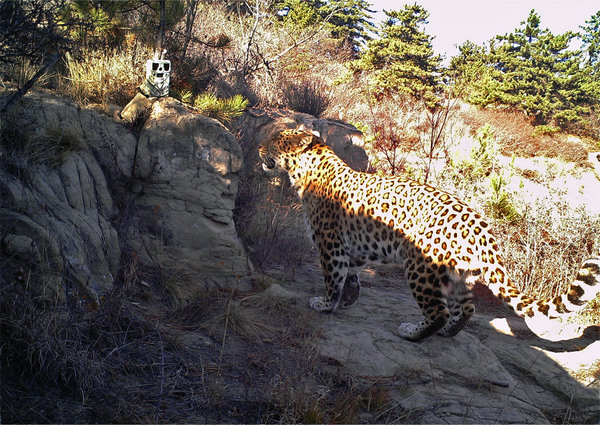Small group claws its way up
By Xu Lin ( China Daily ) Updated: 2016-03-25 08:39:56
 |
|
Images of wild leopards are captured by infrared cameras in the Taihang Mountains in Shanxi province.[Photo provided to China Daily] |
Shedding more light on the big cat-livestock issue, Feng Limin, a big cat expert from Beijing Normal University and cofounder of the CFCA, says: "Research shows that leopards are resilient to human-dominated landscapes and are restoring their population in the remaining temperate forests in North China."
His research team has also conducted more than 10 years of research on the Amur tiger and Amur leopard in Northeast China.
The Amur leopard is one of the most-endangered of the nine leopard subspecies in the world.
But the university's research shows that the animals' population is recovering and there were at least 42 Amur leopards spotted in the wild in 2014.
With regard to the falling number of tigers and leopards in China, Feng attributes this mainly to loss of habitat, degradation of the prey population and poaching.
But he says recent evidence shows that the number of big cats, such as tigers and leopards, is growing thanks to efforts to connect habitats and ensure minimized human disturbance in those areas.
Looking to the future, Feng says that it is urgent for us to collect information about the status of leopards and their population in China and identify key habitats for conservation.
There should also be a well-planned strategy based on scientific research.
Explaining why this is key, Song says that often the habitat may involve different owners and overlapping jurisdictions. Also, each area may have different policies with regard to conservation.
The CFCA recently launched a crowdfunding project to raise funds for its campaigns and offered to give donors photos, videos, badges and magnets of leopards, and even offered a field trip to their project area.
There's no stopping these eco-warriors it seems as they resort to every trick available to save the leopard.
Contact the writer at xulin@chinadaily.com.cn
|
|
|
|
|
|
|
|






















 Raymond Zhou:
Raymond Zhou: Pauline D Loh:
Pauline D Loh: Hot Pot
Hot Pot Eco China
Eco China China Dream
China Dream China Face
China Face






